Dear Artist,
“There are some artists that want to slow down the world and feel that we need to have the time to be still,” said American photographer Spencer Tunick. “The still image does not give us all the answers. It gives our minds a chance to do its own imagining. This is important.” Tech pundits are currently burying the still and crowning the moving image as the preferred aesthetic experience – for example, the plethora of mindless short videos shoved to the fore on social media. Perhaps the still – as a photograph or rendered image – is dead. But what, if left to our druthers and not the algorithms, do we really long to look at?
Best known for organizing large-scale nude photo shoots and also making videos of the process, Tunick has, over the last 30 years, photographed over 75 of what he calls, “human installations.” By organizing his models across a spectrum of skin tones, hair length and colour, gender, age, and other factors, Tunick uses the nude as a palette. “For me, the nude body is like a raw material,” he said. “Another artist might use oil or clay. I love the fact that, en masse, it can be turned into an infinite number of shapes or abstractions, while the setting I choose – rural, urban, indoors or out – is like a canvas.”
By organizing this palette within architectural settings and other human-made surroundings, Tunick de-personalizes the human form, de-sexualizes it, and invites viewers to consider these temporary and site-specific events in the context of our collective humanity, the environment and our place as a species in the ecosystem. “When you see 300 people naked in Grand Central Station, or a river of flesh flowing through the beauty aisles of Selfridges department store, it makes you think about all sorts of social and political issues.” While composed and planned in detail and often resulting in a highly aesthetic but also non-exploitive, consensual, and collaborative-feeling artwork, Tunick’s photos also make it hard to ignore our exposure to and consumption of horrific historic and present-day images of assembled bodies, of corpses, and our paradoxical treatment of life’s preciousness and ubiquity.
Sincerely,
Sara
PS: “Individuals en masse, without their clothing, grouped together, metamorphose into a new shape. The bodies extend into and upon the landscape like a substance. These grouped masses which do not underscore sexuality become abstractions that challenge or reconfigure one’s views of nudity and privacy.” (Spencer Tunick)
Esoterica: Historically, the nude as subject has reigned as our most important outward and inward gaze: our number-one explorer and signifier of an aesthetic ideal, an instrument of power, objectification, and on a purely technical level, the proving ground for any significant achievement in understanding form; in sculpture, in rendering light and shadow, in anatomical accuracy and in the characteristic line of a one-minute gesture.
Perhaps it is in rendering ourselves, with the features of our species understood most intimately and collectively, where, as draftsmen, we are most universally leveled. If you haven’t tested yourself in a life drawing class, or hired your own model, move this exercise immediately to the top of your personal education. “The human body is the fleeting temple of our souls — the outward, evident skin of the human animal,” wrote my Dad. “Intuitively we know it to be something good and wholesome, and its mystery, wonder and dismaying difficulties humble us.” In Tunick’s case, the portrayal of nudity continues as an instrument of both transgression and organization, grouping compliant models into ordered and regimented systems for the purpose of aesthetic consumption. It is, perhaps, simply an extension of the nude’s historical place as a spectacle in art – at once the most beguiling object of fascination and a voyeuristic invasion – a chance to long-look at the forbidden, without consequence, to gain insight, compassion and understanding for that which we all share.
“There is nothing in all the world more beautiful or significant of the laws of the universe than the nude human body.” (Robert Henri)
Have you considered a Premium Artist Listing? With each letter, an artist is featured at the bottom of this page. The Premium Artist Listings are a means of connecting artist subscribers through their work. Proceeds from each listing contribute to the production of The Painter’s Keys.
“My work’s an attempt to challenge notions about nudity in a public space and how the body is represented in our culture.” (Spencer Tunick)
Featured Workshop
October 17 – 23, 2022
San Miguel de Allende
Painting Mentor – Amit Janco: Artist, Author, Labyrinth Designer, Founder of Heartshops and Retreat on Your Feet (Creativity and Walking Retreats)
Join this 7-day journey through self-expression to unleash your bottled-up creativity, with a brush in hand – and openness in your heart. Calling non-artists too! Each day, you’ll stand up to paint; yes, you’ll be painting on your feet, and moving about – thereby activating the brain, the body and ALL senses. No need to come with a plan; watch the colors and brushstrokes come alive; and see the magic and mysteries unfold, as you greet your square of paper anew, every day. Our accommodations and studio are in an enchanting former bordello, just a stone’s throw away from San Miguel’s historic center, with its gardens, cobblestoned alleys and marvelous colonial architecture. Inspiration abounds!
Details at https://amitjanco.com/
Featured Artist
We live in a fractured world. Wars, famine and power games are forcing people to abandon their homes and their way of life in hopes of finding peace. For lack of education or specialized skills, the poor are not accepted into our northern communities. They stay in the camps on the borders of turmoil, separated from local community. Animals are caught in the crossfire. Even the trees and the rocks suffer the agony of imbalance. This chaos is evident in my work. In between the rivulets of paint and the textural accidents I choose colours and forms to suggest a landscape where beauty continues to reign. We can still change the tide and build a new world harmony. Certainly, contemporary will focuses on gold instead of beauty. Yet, beauty is essential to the wellbeing of the planet. She is essential to the survival of humanity.

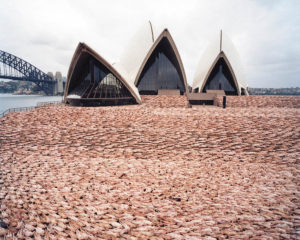
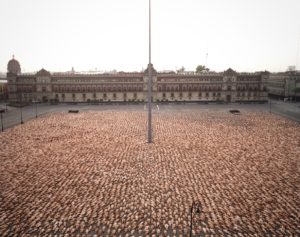
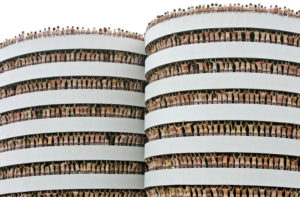
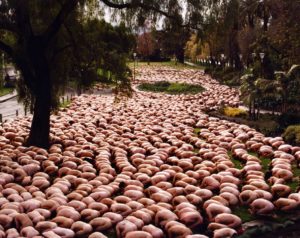
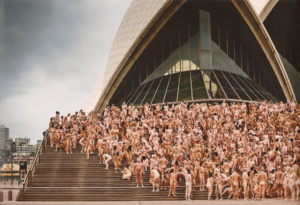

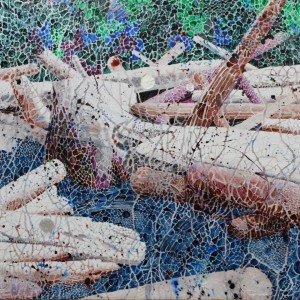
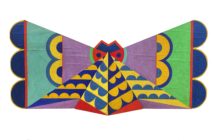
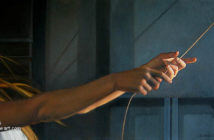
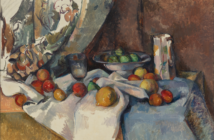
23 Comments
Regardless of Spencer Tunick’s artistic intent of displaying nudity in public spaces his work has always distracted me from analyzing it any further than to ask: Where did all those people put their clothes, shoes and valuables during the photo shoot?
EXACTLY what I have thought over the years! I can imagine someone at the end of the shoot wandering around naked wondering just where the hell their clothes went!
“When you see 300 people naked in Grand Central Station, or a river of flesh flowing through the beauty aisles of Selfridges department store, it makes you think about all sorts of social and political issues.” No, Spencer, it does not.
I find this singularly incomprehensible.
This is so fascinating to read more about his work! I shared the article with my students – I teach figure drawing at a community college. I’ve noticed that drawing the nude human form gives me such appreciation for how amazing bodies are and has led to a healthier relationship with my own body. I always tell my students, and this relates to the still image of the body, ‘it’s a privilege for us to be able to study the human body – not in a medical situation or a caring for sick/elderly situation, but just with a calm, curious gaze and the question of how you’re going to represent that on a 2 dimensional piece of paper’.
Thanks for this!
An intriguing concept, but I cannot help but note that, as far as I can tell by enlarging each photo as much as I can, the artist has not included a single black body in any of his installations. I see pink, beige, a pale shade of brown in one single one–but where are the beautiful tawny shades, the rich chocolates and ebonies of the rest of our human family? There’s a political statement, intended or not, here!
Sadly this grand adventure in are does not work for me. I find the body palette too limited (as mentioned there are few if any deep dark skinned bodies.) Also I find the conglomerate of bodies unattractive, like an army of slugs and a pile of piglets. Not all art need be beauty, but I find I need a lot of beauty in this crumbling world.
There aren’t many but there are a few black bodies. The easiest to see are the black people in the Netherlands 8 photo. If you look for the dark spots, they almost, but not quite look like gaps between the sea of white people. I can see at least 5 different black bodies and there is at least one in the Mexico City 4. But, yeah, there aren’t many.
Should there be 13.5% burnt umber? Maybe he just couldn’t get them to volunteer?
For me, the body of blacks, as a group, Arranged in Tunicks method, shades of black would be so much more interesting. Black is beautiful, as I’m sure you’ve heard.
Tricky, digital playing….impossible to believe the photographer got that many people to strip for all the time taken to get together and pose in nearly the same way…over and over. Sorry, but something is fake here.
I am fascinated by how the people become texture and tone, and they lose their identity. it is a visual paradox to have such openness become less than actual people. For me it does open up questions about humanity up close in the singular versus humanity in the vastly plural and distance. I have admired his work for years. I do teach and work from the figure so maybe I am less distracted by the nudity.
BTW his work is well-documented. I had noticed less people of color, but you can’t gang press people to volunteer, maybe less dark skinned people were interested or aware of calls to participate. I seriously doubt it is intentional.It is also true that, in this kind of situation, dark skin may show as a gap, just because of light and distance.
Too bad people are made uncomfortable by unclothed bodies – we all have one, after all. I don’t think these are the greatest photographs ever (too much reliance on pattern for me), but they are definitely an expression of an artist’s idea, and they certainly provoke conversation! Never a bad thing to talk about art…..
I guess I have been brain washed over seven decades as to what a beautiful human body looks like. And this is not it. This ‘art’ by Tunick made me nauseous and does nothing to desexualize my relationship with mine or anyone else’s body. I see absolutely nothing beautiful about most of these bodies. And having your bent head next to someone’s arse is not my idea of an uplifting art experience. But then, we’ve read that part of the purpose of Art us to evoke emotion. That, it does! In spades!
I can’t believe the quite negative and disbelieving comments here; people should do their homework before commenting. As a member of the “open call” for the 2010 Sydney Opera House, I know from personal experience that Tunick doesn’t select people but uses those willing to come and participate. He has no say in who responds, nor they’re skin color. If no black or dark skinned people show up to the very early morning request, that’s a reflection on the population density and the personal outlook of individuals residing in the surrounding environs. These mass experiences are very well coordinated; if you’re wondering about clothes, you’ve missed the point. There are films showing his methods, personal interactions with staff and participants, and are easily researched.
The only photo I can tolerate to look at is ‘Netherlands 8,’ because it is clever and doesn’t give the impression of slaughtered people/animals. All the rest look like dead bodies & genocide–too close to what’s happening in Ukraine now, as well as the Nazi concentration camps. Don’t get me wrong–I think the nude body is beautiful in itself, and I’m definitely not a prude. Some of my best life drawings were of nude people.
I want to like this work, I always want to appreciate what any artist is trying to do, especially when you see the sheer effort of organising something on this scale…but when I find myself not wanting to look at it instead of wanting to looking at it, being turned off instead of turned on, I have to try to understand why. I always look at the pictures before I read the letters, and at first I thought I was looking at shrimp. Then it dawned,-bodies. And I can see how making this kind of work could be good craic, and being involved could be good craic, but I fail to find any meaning. In this kind of contrivance, I find no humanity or connectivity. Gatherings usually have meaning for us, especially on a large scale, everyone in a row arse to head, my mind turns teenage smutty and I think , “Don’t fart.” As human beings, we are very sensitive to each others presence, we intuit signals, no matter how subtle, we are moved to understand and see each other through and beyond the physical powerhouse of bodily expression, because something in us reaches out to other at a fundamental (conscious?) level.
For a time I was fascinated by post-mortem photography and post-mortem paintings. I was trying to figure out why, in static images, do we know that a person is either alive or dead. And we do know. What do we pick up on? What is the signifier of aliveness? When I look at these photos, like some of the comments above, I am struck by that to which I can empathise, which is the likely experience of the people participating in this hooha…the experience of “Jaysus, I hope I don’t fart”, and “where the hell did I leave my shoes?” Nothing more. All that effort, to say nothing at all.
The responses by people in the comments are as fascinating as the photos are to me. All different reactions on so many levels after looking deeply at these intriguing photographs. Practically speaking, I wonder how much they got paid to model. The un-posed photo says a lot, people there to do a gig and have forgotten they are unclothed it seems. Artistically speaking, WOW!! I’m impressed with Tunick’s use of medium, the human body, to create extraordinary works of art in a photograph. Politically speaking, yes, during these times of having to regulate my time watching CNN out of personal disgust over what Putin is doing to the fellow human body, Tunick’s works remind me how quickly we numb down to seeing dead bodies on our tv screen. How quickly we detach from human life, and just carry on. Great letter on so many levels, Sara, thank you for my Friday lesson. :)
Has anybody ascribing deep meaning to this nonsense ever heard the story of the Emperor with no clothes?
Seeing the grouped humans like this is oddly moving and does make me think broadly about the human existence. It makes me think about our shared humanity, our vulnerability. About religion and climate change. About history. I love these photos, especially the Melbourne one. Kudos, Mr. Tunick. Thank you, Sara, for making me aware of his work.
While the patterns and textures created are intriguing, knowing the raw material used, the overall composition of vast pink fields seems monotonous in the first two photos. And while admiring the shimmering flesh color, I also feel a gut-level repulsion to what could almost be a teeming mass of netted fish. Moving on to Netherlands 8 brings some relief; a sense of delight and whimsy, with bodies no longer prone. Then there is a measure of awe while viewing Melbourne 3’s slithering river of smoothed, salmon-hued rocks. Conflicting my appreciation of these works as art, is concern about all these obedient minds and bodies doing as told for the reward of being a tiny part of one famous man’s idea, and, I suppose, to partake of a social happening. Do any of them make friends or even meet a mate? These photos also say something about the number of (ordinary?) people who jump at the chance just to get naked with others!
Paintings of the human body have been a standard for artists over the centuries. We have come to see these works as beautiful, intriguing, insightful. But to take that concept and fill marketplaces, waterfronts or stadiums with nudes feels like the ‘big Mac’ version of art. There is no focus, no insight, no taste in these works. Just filler.
This set did elicit a good number of responses. Since I first saw is work I have thought that all the work involved might have resulted in stronger images. I realize his interest is not in the figure(s) itself, but all of these images seem like snapshots or inventory reference. Another eye might have done more with the material.